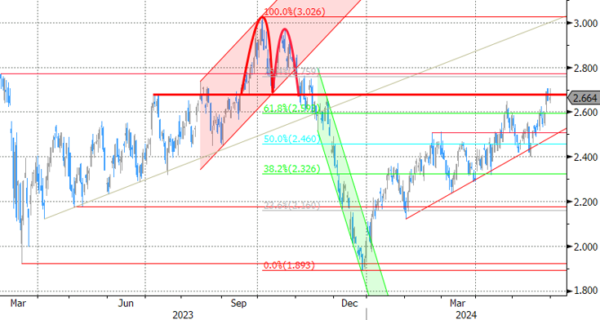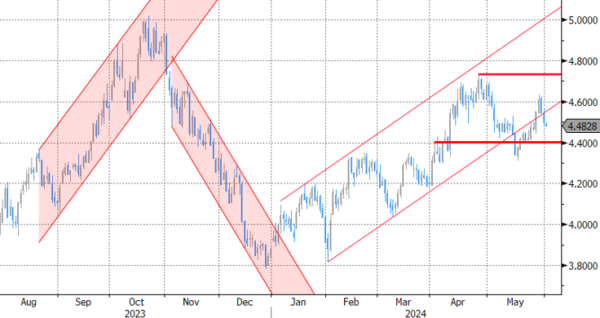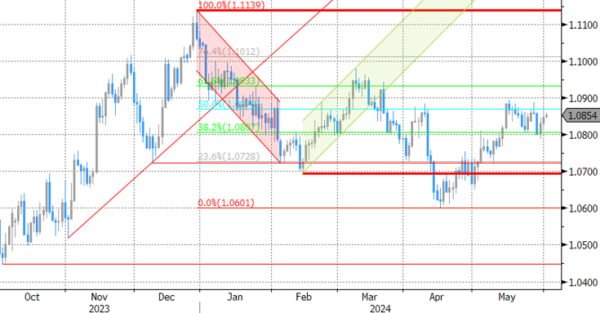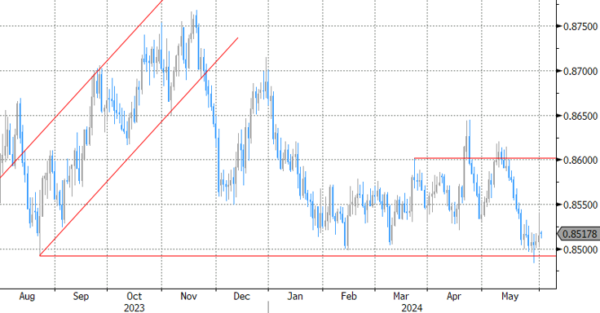Markets
US Treasuries closed near Friday’s best levels on slightly softer April spending figures and a slower (but in line with forecasts) core PCE deflator pace. Daily changes on the US yield curve ranged between -6 bps (5-yr) and -3 bps (30-yr). This contrasted with yield increases of up to 2.5 bps (3-yr) in Germany on the back of accelerating May EMU CPI data (core: 2.9% Y/Y from 2.7% Y/Y). The combination pushed EUR/USD to the high 1.08 resistance area, but a real test didn’t occur. The pair closed the week where it started it, near 1.0840. US stock markets avoided losses thank to a late-session sprint higher which resulted in gains of up to 1.5% for the Dow Jones. For once, the tech-heavy Nasdaq underperformed (flat).
The May US manufacturing ISM kicks off a data-heavy US week today. Consensus expects a marginal improvement from 49.2 to 49.6. Apart from a one-off in March this year, the manufacturing ISM is in recessionary territory since November 2022. US Jolts Job openings are on tap tomorrow followed by ADP employment change and the services ISM on Wednesday. Payrolls finish it off on Friday. Don’t look for Fed speeches as the black-out period in the run-up to the June 12 policy meeting kicked in. From a market point of view, the flavour of the US data could switch the needle again between September and December for a first rate cut but this will likely keep US rates within recent trading ranges (eg US 10-yr yield 4.3%-4.73%). Focus on the EMU side turns to Thursday’s ECB meeting which will bring a first 25 bps rate cut to the deposit rate (3.75% from 4%). The bigger question remains whether the central bank commits to any guidance for the following meetings, something they refused to do so far. Sticky Q1 wage growth, the bumpy inflation path ahead, recovering economic growth, and the Fed’s reaction function all suggest limited scope to for follow-up cuts. We nevertheless think that the ECB will keep the option open. Given current market pricing (2nd rate cut only discounted in December), this leaves scope for a more dovish market reaction at the front end of the curve (in the euro’s disadvantage) in a steepening move. We see the longer end of the curve underperforming in such scenario on rising inflation expectations.
News & Views
Rating agency S&P cut the French credit rating from AA to AA- with a stable outlook as public finances are a huge concern. S&P expects the French debt-to-GDP ratio to increase to increase to 112% of GDP in 2027, from about 109% in 2023, which would be the third highest in the euro area, after Greece and Italy. Last year’s budget deficit came out at a higher than expected 5.5%. While the rating agency expects the deficit to shrink due to the economic recovery and recently implemented economic and budgetary measures, it will still average 4.6% over the 2024-2026 period before declining to 3.5% in 2027. In a broader perspective, S&P also assesses that France’s track record of fiscal consolidation has been weak over the past decades. It has not reported a primary budget surplus since 2001. The agency expects interest rate payments to increase to 5% of generaml government revenues in 2027 from 3% in 2023. Even so, the pass-through is mitigated due to the long maturity of France’s outstanding debt (> 8.5 years).
OPEC+ decided to extend the level of agreed production cuts for an amount of 3.66mn b/d until the end of 2025. Aside from these cuts in the general framework, eight members of the cartel, including Saudi Arabia and Russia also committed to 2.2mn of voluntary cuts. These cuts were due to expire at the end of June, but are prolonged untill the end of September 2024. Afterwards, they will be gradually reduced between October 2024 and September 2025. The meeting this weekend also addressed the issue on the capacity targets of individual members. The group intends to decide on capacity levels on the basis of an external review as a reference for 2026. Even as production cuts have been prolonged, the oil price (Brent crude) dropped to currently $81/b. That’s probably as markets doubt whether demand will be strong enough to digest the gradual reduction of the voluntary production cuts.
Graphs
GE 10y yield
ECB President Lagarde clearly hinted at a June rate cut which has broad backing. A more bumpy inflation path in H2 2024, the EMU economy gradually regaining traction and the Fed’s higher for longer US strategy make follow-up moves difficult. Markets are coming to terms with that. The German 10y yield is setting a new YtD top.

US 10y yield
The Fed in May acknowledged the lack of progress towards the 2% inflation objective, but Fed’s Powell indicated that further tightening was unlikely. Soft US early month data triggering a correction off YTD peak levels. However, the Fed minutes still showed internal debate whether policy is restrictive enough. Sticky inflation suggests any rate cut will be a tough balancing act. The US 10-y yield is rebounding in the 4.30/4.70% trading range.

EUR/USD
Economic divergence, a likely desynchronized rate cut cycle with the ECB exceptionally taking the lead and higher than expected US CPI data pushed EUR/USD to the 1.06 area. From there, better EMU data gave the euro some breathing space. The dollar lost further momentum on softer than expected early May US data. Some further consolidation in the 1.06/1.09 area might be on the cards short-term.

EUR/GBP
Debate at the Bank of England is focused at the timing of rate cuts. Slower than expected April disinflation and a surprise general election on July 4 suggest that a June cut in line with the ECB looks improbable. Sterling gained momentum with money markets now discounting a Fed-like scenario. EUR/GBP tested the 2023 & 2024 lows near 0.85. We expect this important support level to hold.










